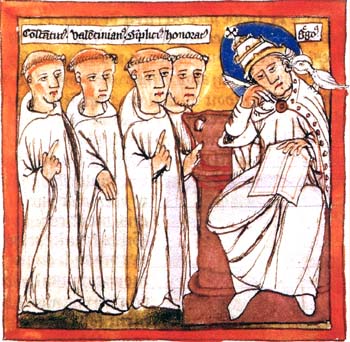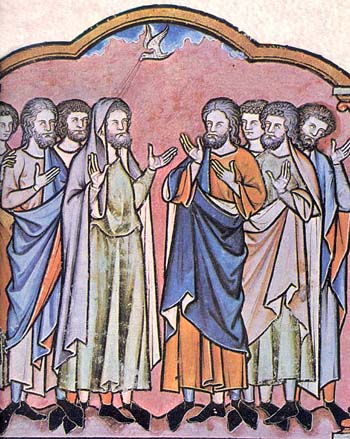 |
The Saint of the Day
St. Ethelbert of Kent, February 25
Prof. Plinio Corrêa de Oliveira
Biographical selection:
In the 6th century, Pope St. Gregory the Great sent a group of missionaries under the authority of St. Augustine to England, which was pagan. Reaching the Isle, the apostles announced their arrival to King Ethelbert of Kent, telling him they brought the message of eternal life. Through his wife Bertha, the sovereign had already heard about the Catholic religion, and he promised to receive the group in a public interview.

St. Gregory the Great sent monks to the Anglo-Saxons
|
The monks arrived in procession carrying as a standard the silver cross of Our Savior and singing litanies to God asking the salvation of this people. The Sovereign ordered them to sit, and they began to preach the Gospel.
Then Ethelbert said: “Your words and promises are very beautiful. But because they are new and uncertain, I cannot approve them and leave everything that I along with all my people have followed for so long a time. However, since you have traveled from afar and made a long journey in order to share with us what you deem to be truer and better, I will not place obstacles in your way, but will receive you well and offer what is necessary for your subsistence. Nor will I impede you from bringing to your religion all those whom you are able to persuade.”
The King provided them a place to live in the region that would later be called Canterbury. Some time after, impressed with the example of the monks and their doctrine, King Ethelbert converted and was baptized, bringing a large part of his people with him into the Church.
The last 20 years of his life he dedicated himself to propagating the Catholic Faith in his kingdom. Supported and encouraged by Pope Gregory the Great, he built churches and offered protection to Catholics in his lands. He also endeavored to convert the neighboring princes and brought the King of the East Saxons and the King of the East Angles into the Church. St. Ethelbert died in 606. His example bore much fruit for no other nation ever gave the Church so many saintly Kings as England did.
Comments of Prof. Plinio:
Here you see two great figures who were founders of the Middle Ages. A great missionary, who is St. Augustine of Canterbury, comes into contact with a great founder King, who is St. Ethelbert. I call him a founder King because before his conversion, England was a kind of agglomerate of pagan barbarians. There was not, properly speaking, an English civilization or an England as a nation. What existed were only the seeds of the future England, which, placed in contact with St. Augustine, grew and gave rise to that country.

The solemnity of the preachers and the supernatural grace of their words moved the heart of the pagan king?
|
The solemn ceremony described in this text is truly magnificent. You can imagine the King and his semi-barbarian warriors in a clearing in the woods awaiting the arrival of the missionaries. St. Augustine and his monks ceremoniously arrived at the meeting spot and began to speak. The heart of St. Ethelbert was touched by St. Augustine from the beginning. He gave St. Augustine liberty of movement and speech in his realm, even though he said he could not agree to a change of religion so quickly. He wanted to study everything more carefully.
But the King’s sympathy was already apparent for he offered them a place to stay, thanked them for making the long journey, and told them they could receive all the people who wanted to come to the Catholic Religion. He revealed an inclination to the Truth, which he had just begun to hear.
St. Augustine established himself in the region and preached the true religion. After a time, the King not only gave his entire adhesion to the Catholic Religion after examining it, but he also brought two other neighboring Kings into the Church. It is proof that the liberty he gave to St. Augustine was the first step of his conversion.
From this you can see that anyone who has contact with the Catholic Religion and is moved by grace has the possibility to discern that he is dealing with the true Religion and give his adhesion to it.


  |
| Prof. Plinio Corrêa de Oliveira |
|
The Saint of the Day features highlights from the lives of saints based on comments made by the late Prof. Plinio Corrêa de Oliveira. Following the example of St. John Bosco who used to make similar talks for the boys of his College, each evening it was Prof. Plinio’s custom to make a short commentary on the lives of the next day’s saint in a meeting for youth in order to encourage them in the practice of virtue and love for the Catholic Church. TIA thought that its readers could profit from these valuable commentaries.
The texts of both the biographical data and the comments come from personal notes taken by Atila S. Guimarães from 1964 to 1995. Given the fact that the source is a personal notebook, it is possible that at times the biographic notes transcribed here will not rigorously follow the original text read by Prof. Plinio. The commentaries have also been adapted and translated for TIA’s site.
|
Saint of the Day | Home | Books | CDs | Search | Contact Us | Donate

© 2002- Tradition in Action, Inc. All Rights Reserved
|
 |
|